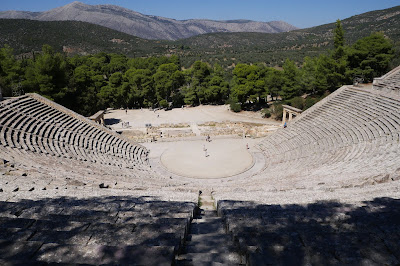The Theatre of Epidavros
The site of Ancient Epidavros (or Epidaurus) is principally famous for the Temple of Asklepius (the God of Medicine and Healing), which is sadly but a ruin, and the astonishing Theatre. We started with the Theatre. Getting there requires some care as there is a small theatre at Archea Epidavros on the coast and a modern town called Nea (New) Epidavros to which there are many signs on the main road. Ancient Epidavros is well inland and does have helpful brown signs however.
According to the celebrated Roman travel writer Pausanius, the architect of the Theatre was Polykleitos the Younger, and work started on its construction at the end of the 4th Century BC. According to Wikpedia, the theatre had a capacity of 13,000 to 14,000 and hosted music, singing and dramatic games that were part of the worship of Asklepius. It was also used as a means to heal patients, since it was believed that the observation of dramatic shows had positive effects on mental and physical health.
The first systematic excavation of the theatre began in 1881 and several stages of renovation have brought it back almost entirely to its original form. The first modern performance at the theatre was Sophocles's Electra in 1938. Performances stopped during World War II, but the Epidaurus Festival was inaugurated in 1954 and continues today.
You walk along the main path from the entrance and fork right by the museum to reach the entrance to the Theatre. Your first view is quite oblique: you can see the two entrance gates and maybe a third of the seating.
Once inside the seating rears up to a great height and the division into sections divided by staircases becomes more apparent. There are 12 sections in the lower part and 22 in the upper.
Almost all the rows of seats have no backs, but one row about half way up did have seats with backs for distinguished guests.
The view down from the very top row is just wonderful and it is easy to test the fabulous accoustics. You can hear people talking in the circular orchestra quite clearly and while we were there a brave man sang from the centre point and was perfectly audible all around the theatre.
We sat and enjoyed the view for a while, but eventually I felt I had to see if the might any butterflies beyond the top of the Theatre. I had a short but enjoyable foray seeing a Scarce Swallowtail (below), a Swallowtail, a Cleopatra and a Freyer's Grayling, previously spotted in Mycenae.
Eventually we headed back past the museum to see the rest of the site. At first all we could see were the outlines of where several buildings had once stood ...
... but soon we passed the wonderful sight of the Stadium, in use in 500 BC and still used today for sports events by the children of local schools.
The other surprise was the round building called the Tholos which dates from the middle of the 4th century BC. This was also teh work of the architect of the Theatre, Polykleitos. The name Tholos was used by the intrepid Roman traveler Pausanias, but it seems that he may possibly have got it wrong - we saw a couple of burial chambers with this name at Mycenae. A helpful information panel reveals that it was actually called a thymele or (sacrificial) altar.
It is seemingly in the process of being at least partially re-created: several new marble columns are in place and the parts of others are scattered around. It will be a wonderful sight when (or perhaps if) its double circle of columns is finished.
Conditions: hot and sunny.
Rating: five stars.










No comments:
Post a Comment